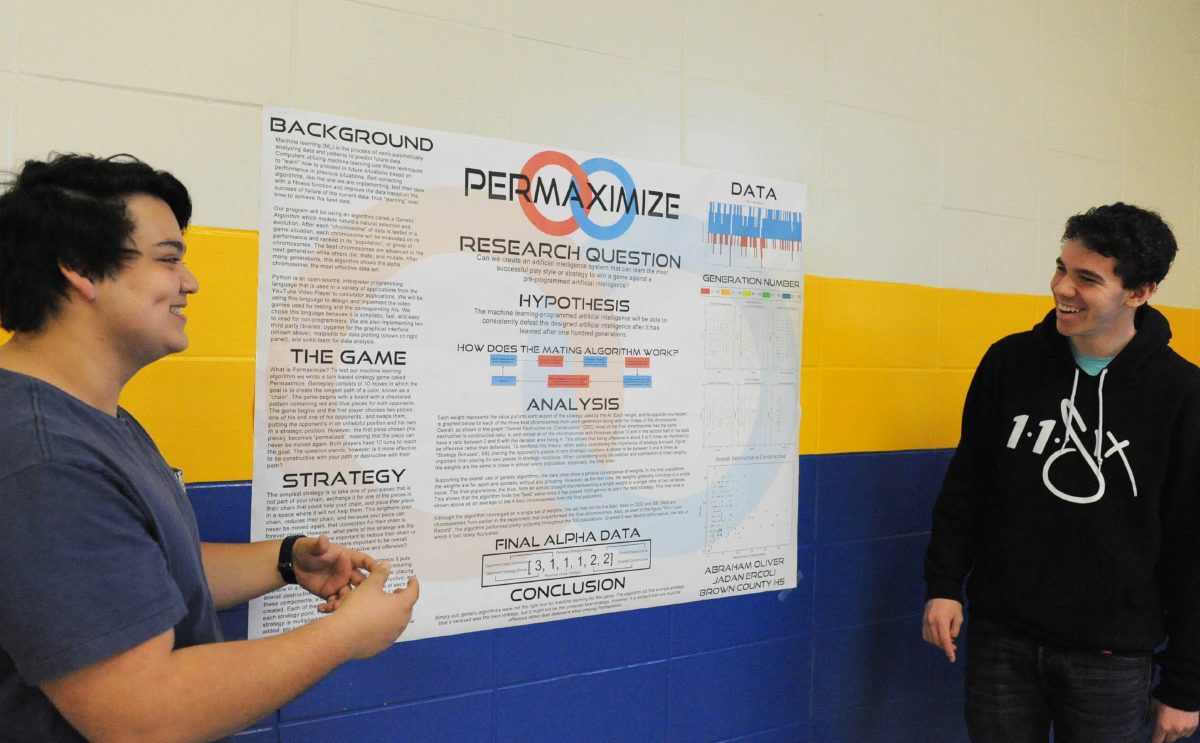
A video game that learns from its mistakes to defeat its opponent.
A psychological study on what factors lead to successful interracial interactions.
These are the student projects that will represent Brown County at the Intel International Science and Engineering Fair from May 8 to 13 in Phoenix, Arizona.
Sophomores Abe Oliver and Jadan Ercoli and senior Corina Greiner are the first local students to attend the fair, where they will compete with about 1,700 high-schoolers from around the world.
[sc:text-divider text-divider-title=”Story continues below gallery” ]Eighteen finalists from Indiana were picked at the Hoosier Science and Engineering Fair on April 2 in Indianapolis.
Assistant Superintendent Dennis Goldberg made sending students to the Intel ISEF a goal when remodeling began on the science labs in the school, said Paige Burton, high school math teacher and the regional fair coordinator for Brown County Schools.
“I think this was our best year yet at the high school level,” Burton said. “They really stepped it up this year to make a better showing, and obviously, they did pretty well.”
“I take it as an honor, really,” Ercoli said.
“We’re more interested in learning what other people have, looking at better ideas for next year, learning from our peers who have advanced farther than we have,” Oliver added.
Gaming the system
Ercoli and Oliver created a video game called “Permaximize.” One player uses a strategy that the duo defined, while the other uses a strategy that evolves over time.“It learns from its mistakes to get a better strategy,” Oliver said.
A person can play the game on their own or they can play against the computer.
The game is similar in concept to the board game Connect Four and looks similar to checkers and chess.
“The goal of the game is really to move two pieces, yours and your opponent’s, or yours and your own, to get a better position, ultimately making the longest chain of your color,” Ercoli said.
The two hypothesized that after 1,000 games, their artificial intelligence would win 75 percent of the games.
“However, it started out winning 75 percent of the time. It never went below 75 percent of the time,” Oliver said.
The artificial intelligence Ercoli and Oliver created — in the basement of Oliver’s home using his laptop and mostly free online software — is modeled after natural selection, they said.
“Strategies mate with each other and create hybrids and pass their genes down,” Oliver said.
Both students put in about 500 hours since the fall semester and wrote 60 pages of code for the winning project — including working around 50 hours during their spring break vacation to Alabama.
The main focus of the project is artificial intelligence and machine learning, but they needed a physical representation of the learning, so they decided to create a video game.
Strategy games “Othello” and “Pathogen” provided inspiration, Ercoli said.
Besides exploring the concept of artificial intelligence and machine learning, Ercoli and Oliver hope their project inspires more computer science education curriculum in the schools and community.
“We feel like this is sort of a catalyst to showing kids what can be done with this scale to hopefully get some more interest in our school going,” Oliver said.
Both plan to study computer science after high school. Ercoli is considering Indiana University while Oliver has his sights set on Stanford.
Racial interaction
Would a white person think a black person would not want to be their friend if the black person’s existing friend group were all-black?
That’s the question Greiner is answering with her study titled “The Role of Friendship Networks and Motivational Goals in Interracial Interactions.”
“Basically, what I was interested in looking at was how the diversity of one’s friendship network and motivational goals can create what’s called an identity-safe environment,” she said.
In such an environment, a person would not feel stigmatized because of their race, religion, gender, etc., she said.
The two motivations are either interacting to not be seen as prejudiced, or interacting for the sake of interaction and personal growth, Greiner said.
Greiner completed her study in Indiana University assistant professor Mary Murphy’s lab in the Department of Psychological and Brain Sciences. Murphy studies stereotype threat and interracial interactions.
Greiner started working in the lab over the summer when she applied to participate in the IU Project SEED program, an internship for high school students.
Her hypothesis was that a white person who anticipated interacting with a black partner with all-black friends would experience the most identity threat, and “thus would show more negative emotions towards the upcoming interaction, less feelings of being capable to meet the demands and less certain that their partner wanted to be their friend,” she said.
The study proved that diversity does help form friendships.
For Intel ISEF, Greiner plans to further her study by replacing the white friends with Asian friends to see if it has the same effect on the white participant.
Greiner plans to study biology and Spanish and minor in neuroscience and psychology at IU next fall. She was named a Wells Scholar earlier this year.
Her goal is to become a pediatric neurologist.
She spent about 600 hours preparing her project. She currently works about six to eight hours a week conducting the research at IU.
The study of interracial interactions is important to the future of the world, Greiner said.
“As America increases in globalization, there will be more interracial interactions, so we need to figure out how to interact with each other without feeling tense,” she said.
“Racial tensions have caused wars and have caused deaths and have caused real consequences for our nation, and it’s still continuing to this day. It’s not just even in America, it’s about the whole world.”

